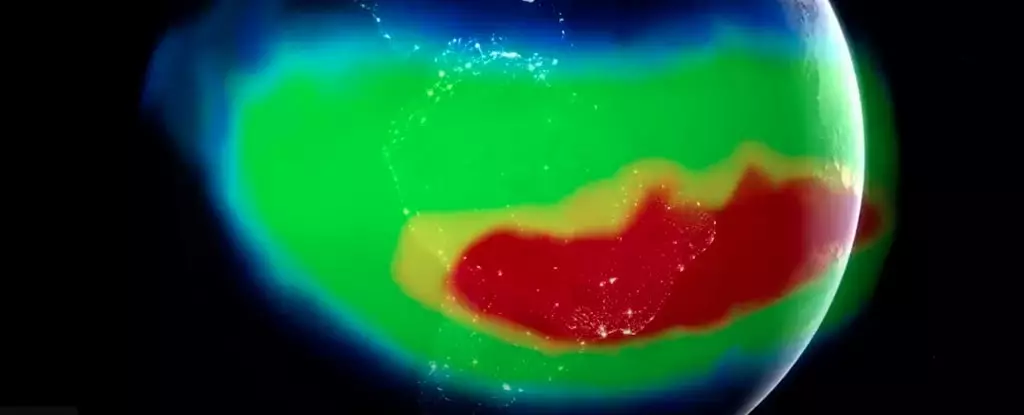Orbiting above Earth is an astonishing phenomenon known as the South Atlantic Anomaly (SAA). This peculiar region, which stretches from South America to southwest Africa, is characterized by a significant decrease in magnetic intensity. While this anomaly poses minimal risk to life on Earth, it presents a formidable challenge to the technology that keeps our satellites and space missions operational. The SAA has become a focal point of research for scientists, particularly at NASA, who are keenly aware that understanding this anomaly could unlock secrets about our planet’s magnetic field and its broader implications for space exploration.
The description of the SAA as a “dent” or “pothole in space” vividly illustrates the anomaly’s nature—an area where Earth’s magnetic field is unusually weak. Such characteristics lead to increased exposure to charged particles from the Sun, specifically high-energy protons, which can wreak havoc on electronic components aboard spacecraft. This area of concern is especially relevant for satellites that orbit in low-Earth orbit, such as the International Space Station (ISS). When these technological marvels navigate through the SAA, they are at risk of experiencing system glitches or, worse, permanent damage due to exposure to concentrated radiation. Consequently, operators often preemptively shut down sensitive systems before entering this enigmatic zone—highlighting the urgent need for thorough research and understanding.
What Lies Beneath the Surface?
At the heart of the South Atlantic Anomaly’s mystery is Earth’s magnetic field itself. Geophysicists, such as Terry Sabaka from NASA’s Goddard Space Flight Center, are piecing together the puzzle of how molten iron flowing thousands of kilometers below the planet’s surface generates this magnetic shield. While this magnetic field is critical for life as we know it, it is not uniformly distributed. Researchers have posited that geological features like the African Large Low Shear Velocity Province—a massive underwater reservoir of dense rock—are partially responsible for the SAA’s unusual characteristics. The relationship between the molten iron movement and these subterranean geological elements is where the intrigue lies.
Moreover, scientists have noted that the weakeness of the magnetic field in the SAA can be attributed to the dominance of the dipole magnetic effect being disrupted by opposing forces within the region, leading to localized areas of reversed polarity. This complex interplay generates significant questions about the stability of the Earth’s magnetic field as a whole and whether or not shifts in this system could lead to larger geological or climatic changes on the planet’s surface.
The SAA’s Evolution and Its Future
The South Atlantic Anomaly is not a static feature; it has been observed to drift and even divide. Researchers, including NASA heliophysicist Ashley Greeley, have documented that the SAA is steadily moving, a finding crucial for understanding its long-term behavior. More alarmingly, recent studies suggest the SAA is in the process of splitting into two distinct cells, each demonstrating its own localized area of minimum magnetic intensity. Such revelations underscore the dynamic nature of the SAA and provoke critical questions regarding the implications of this bifurcation for both Earth and the missions conducted above it.
Returning to the timeline of the anomaly, some researchers speculate that the SAA is not merely a recent occurrence but rather a recurrent event that has manifested multiple times over the past 11 million years. This lends credibility to theories suggesting that the SAA may not signify an impending flip of Earth’s magnetic field—a phenomenon that can take hundreds of thousands of years to unfold. Such a perspective allows scientists to explore the historical behavior of the Earth’s magnetic shield and the conditions under which anomalies like the SAA may surface.
The Importance of Continuing Research
The ongoing study of the South Atlantic Anomaly holds implications far beyond immediate technological concerns. Understanding its origins and future trajectory may not only enhance our grasp of Earth’s magnetic field but also influence space exploration strategies for humanity. The anomaly’s slow drift and splitting behavior emphasize the necessity for continuous monitoring and targeted research missions to gather more accurate data.
As we hone in on the various aspects of the SAA, one can only hope that the dedicated efforts of scientists around the world will unlock the secrets of this magnetic puzzle. By continuing to observe the anomaly, we not only safeguard our technological investments but also enrich our understanding of the Earth’s dynamic systems—ultimately enhancing humanity’s capability in the uncharted realms of outer space. The endeavor to unravel the nature of the South Atlantic Anomaly is indeed a journey worth taking, as it may well pose answers to questions we have yet to consider.


Leave a Reply